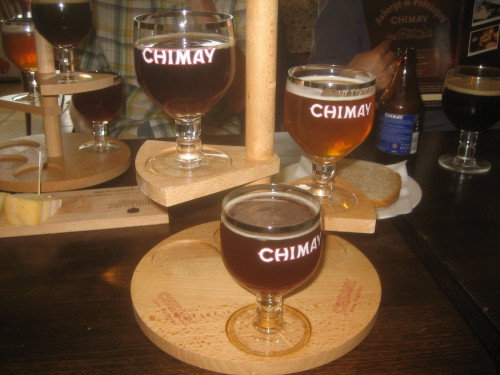On Tuesdays here in Topeka, the local bike club has recently started a ride that starts at PT’s Coffeeshop and only rides down the bike path. It was meant to attract new riders to the sport. A few new guys have shown up, so that is great, but in reality, Tuesday has become the new Monday rest day. With that, it has become a social gathering and beer drinking session.
I’ve participated the last two Tuesdays. I can’t keep up though, so I’m going to eventually have to surrender. I’m one of the lucky guys that pays the next morning for drinking too much beer the night before. I’m not sure if “training” would help, but right now the after effects aren’t worth it.
Anyway, I’ve had this theory, well, not really a theory, but an observation, that for a sport to be successful as a spectator sport, there has to be beer and drinking involved. That is nearly a fact for American sports. Think about it- football, baseball, Nascar, hockey, you name it, there is drinking involved always.
It is the same for cycling in Europe. Spectating cycling and drinking goes hand in hand. Especially in Belgium, the king of all countries when it comes to beer. During he classics, cyclo-x, the start money criteriums after the Tour, all involve a huge amount of drinking while spectating.
Most of the truly successful big races in the US that I’ve done over the years are at venues that allow drinking. The first one that comes to mind is Athen Twlight Criterium. I pretty much refuse to ride that race now because of an over 50% crash ratio over lifetime participation, but I have to admit that Gene Dixon has a perfect formula for attracting spectators. The whole course is nearly a street party for the whole evening.
Tulsa Tough is relatively new event that has finally started attracting very good riders and a very good spectator base. Most of the spectators at Tulsa aren’t bike race fans. They are just regular people that have heard that the bike races are a very fun time and nearly a street party. After coming, they become bike race fans. That is the key.
For a sport to be successful financially, there has to be a fan base that doesn’t necessary have any desire to take part in the sport personally. Cycling in the US doesn’t have that fan base now. It had that fan base in the 70’s, but somehow lost it. To get it back, guys riding around in circles isn’t enough. Adding beer to the mixture just might be.
Blue Dome Criterium at Tulsa and especially The River Criterium with Cry Baby Hill have both become very spectator friendly. Part of the success is because of the festive atmosphere. Here a video from Cry Baby Hill that I took just pre-riding the course.
Tulsa Tough Cry Baby Hill Pre- Ride 2013 from Steve Tilford on Vimeo.






Do you find any irony that the spectators need a PED (entertainment enhancing intoxicant, actually) to enjoy the events?
Wagering and fantasy teams help as well..
Why does this make me think of clowns with big red noses riding funny bicycles in circles in a circus?
Don’t forget Edwardsville Rotary Criterium – http://edwardsvillecriterium.com/
I know you have raced this one before – who could forget the infamous riding with a jagged seat post.
Beer…and gambling. People love gambling, bike racing is a great sport to bet on.
The Moline Criterium had beer. It was successful in the late 80s with lots of spectators. They moved to a new location and I don’t think they have beer anymore. Do they have many spectators now?
Not just for spectators! Participants too … hand-ups are not a crime!
@steve, what do people do on mondays now that tuesday is the new monday?
Franz – No, Rock Island isn’t close to Moline. I was going to use Moline as a great example, but it has been gone too long for everyone to relate.
Jed- Monday is the normal continuation of the weekend races, so Monday Nite Worlds instead of Tuesday Nite Worlds.
Dude. Hold your phone level / landscape when taking video.
This reminded me of two beer and cycling scenes, which both fell into the “didn’t see that coming” category.
One, on the first night of the first year of SFTT, spectators dressed to the nines in evening attire drinking beer and watching the twilight crits in the Blue Dome District. Turns out they had all just left the downtown Performing Arts Center a block away where the Lion King was playing, stumbled onto the races and decided to stay.
Second, Belgians drinking Bud Light at CX worlds in Louisville. Go figure.
Malcolm McCollam, Executive Director, Saint Francis Tulsa Tough
Actually, in most states it is! It is often a criminal violation to have an open container or to drink alcohol in unlicensed public spaces. It may not have a “victim”, but that doesn’t make it legal. Not that I like the law…
The Downer Ave. race during ToAD has also been quite successful with the block party/bike race vibe
Gene Dixon is the devil, I think I may still be waiting on a $12 check from 1992. I hear you on the crap shoot, here’s to plowing headlong into the GA Theater in the rain. Now that was a reason to drink
Moline seems to be the classic example of a primarily blue-collar and non-cycling fan base watching what was back then a very underground substrate of American culture line up 100 deep on expensive Italian bikes, and crash into narrow corners at 30 miles an hour. I did it twice, as a junior and senior, and still is the benchmark for all hell and brimfire crit racing out there. And, if I remember correctly, it was either 40 degrees and raining or 120. We all took it dead seriously as sport–the fans fetishiized the whole affair with their drunkenness . . . In essence–this is the kind of thing the sport needs!
The Moline race was in the Belgian part of town. The Belgian Center was behind the announcer’s stand. There is a large number of people in the area of Belgian decent. I think there were at least three bars on the main finishing straight, plus the VFW hall. The Belgian Village on one of the corners has one of the best Reuben sandwiches ever.
Extra points for those that remember when the Moline race had a brick section on the back side, with a manhole cover set in a concrete square raised about an inch above the level of the bricks.